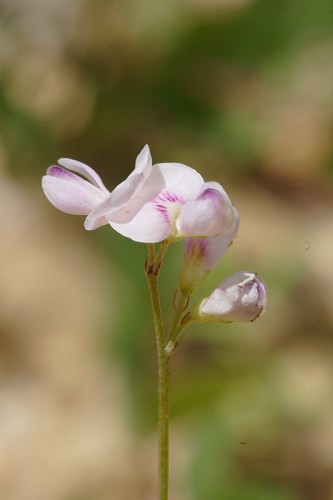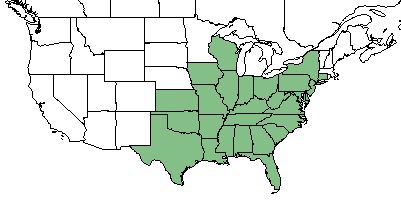Difference between revisions of "Lespedeza repens"
(→Ecology) |
|||
| Line 56: | Line 56: | ||
<!--==Diseases and parasites==--> | <!--==Diseases and parasites==--> | ||
| − | ==Conservation and | + | ==Conservation, cultivation, and restoration== |
| − | == | + | ==Cultural use== |
==Photo Gallery== | ==Photo Gallery== | ||
<gallery widths=180px> | <gallery widths=180px> | ||
</gallery> | </gallery> | ||
==References and notes== | ==References and notes== | ||
Revision as of 16:59, 8 June 2021
| Lespedeza repens | |
|---|---|

| |
| Photo by the Southeastern Flora Database | |
| Scientific classification | |
| Kingdom: | Plantae |
| Division: | Magnoliophyta - Flowering plants |
| Class: | Magnoliopsida - Dicots |
| Order: | Fabales |
| Family: | Fabaceae |
| Genus: | Lespedeza |
| Species: | L. repens |
| Binomial name | |
| Lespedeza repens L | |

| |
| Natural range of Lespedeza repens from USDA NRCS Plants Database. | |
Common names: Smooth trailing lespedeza[1] creeping lespedeza;[2] bushclover[3]
Contents
Taxonomic Notes
Synonyms: none.[4]
Varieties: none.[4]
Description
Lespedeza repens is a dioecious perennial forb/herb.[2] Its stems and peduncles are sparsely short-appressed-pubescent. Stems can grow to 1 m in length. Racemes typically contain 4-8 flowers that are 5-7 mm long. Leaves gradually get smaller towards the stem tips. Terminal leaflets are membranous, elliptic to obovate, glabrous, and can reach 2.5 cm in length.[5] Hybridization of L. repens and L. hirta has been reported in Missouri.[6]
Distribution
This species occurs from Connecticut and New York, westward to northern Ohio, southern Wisconsin, Missouri, and Kansas, and southward to northern peninsular Florida, panhandle Florida, and central Texas.[1]
Ecology
Habitat
L. repens is found in turkey oak sand ridges, dry longleaf pine sandhills, wire grass sand ridges, clay fields, pine flatwoods, and areas with loamy sands.[7] It is also found in disturbed areas including burned longleaf pine forests, along roadsides, fallow fields, vacant lots, and burned saw palmetto-slash pine woodland.[7] Associated species: Tephrosia, Psoralea, Scleria, and Rhynchospora.[7]
Lespedeza repens is an indicator species for the Clayhill Longleaf Woodlands and Panhandle Silty Longleaf Woodlands community types as described in Carr et al. (2010).[8]
Phenology
L. repens has been observed to flower from April to October[9], with peak inflorescence in April. Fruiting has been observed from August to November.[1]
Seed dispersal
This species is thought to be dispersed by translocation on animal fur or feathers.[10]
Fire ecology
L. repens may require fire to maintain higher frequencies. On the Florida panhandle sandhills, its frequency was 25 in 1966. After 57 years of not burning, the frequency dropped to 4.[11]
Use by animals
L. repens composes 2-5% of the diet of some large mammals and 10-25% of some terrestrial birds.[12] During a study in central Texas, L. repens was the most preferred forage in 1996 and third preferred in 1997 by white-tailed deer. The study also showed L. repens is 16.9% crude protien and 78.4% condensed tannin.[13]
Conservation, cultivation, and restoration
Cultural use
Photo Gallery
References and notes
- ↑ 1.0 1.1 1.2 Weakley AS (2015) Flora of the Southern and Mid-Atlantic States. Chapel Hill, NC: University of North Carolina Herbarium.
- ↑ 2.0 2.1 USDA NRCS (2016) The PLANTS Database (http://plants.usda.gov, 12 February 2018). National Plant Data Team, Greensboro, NC 27401-4901 USA.
- ↑ White-tailed deer foods of the United States. The Journal of Wildlife Management 5(3):314-332.
- ↑ 4.0 4.1 Weakley, A.S. 2015. Flora of the southern and mid-atlantic states. Working Draft of 21 May 2015. University of North Carolina at Chapel Hill, Chapel Hill, North Carolina.
- ↑ Clewell AF (1966) Native North American species of Lespedeza (Leguminosae). Rhodora 68(775):359-405.
- ↑ Mackenzie KK (1907) A hybrid Lespedeza. Torreya 7(4):76-78.
- ↑ 7.0 7.1 7.2 Florida State University Herbarium Database. URL: http://herbarium.bio.fsu.edu. Last accessed: June 2021. Collectors: Loran C. Anderson, A. F. Clewell, Angus Gholson, R.K. Godfrey, and R. Kral. States and counties: Florida: Calhoun, Franklin, Gadsden, Jackson, Leon, Wakulla, and Washington.
- ↑ Carr, S.C., K.M. Robertson, and R.K. Peet. 2010. A vegetation classification of fire-dependent pinelands of Florida. Castanea 75:153-189.
- ↑ Nelson, G. PanFlora: Plant data for the eastern United States with emphasis on the Southeastern Coastal Plains, Florida, and the Florida Panhandle. www.gilnelson.com/PanFlora/ Accessed: 19 MAY 2021
- ↑ Kirkman, L. Katherine. Unpublished database of seed dispersal mode of plants found in Coastal Plain longleaf pine-grasslands of the Jones Ecological Research Center, Georgia.
- ↑ Clewell AF (2014) Forest development 44 years after fire exclusion in formerly annually burned oldfield pine woodland, Florida. Castanea 79(3):147-167.
- ↑ Miller JH, Miller KV (1999) Forest plants of the southeast and their wildlife uses. Southern Weed Science Society.
- ↑ Littlefield KA, Mueller JP, Muir JP, Lambert BD (2011) Correlation of plant condensed tannin and nitrogen concentrations to white-tailed deer browse preference in the cross timbers. The Texas Journal of Agriculture and Natural Resource 24:1-7.